![]() 1st Battalion 22nd Infantry
1st Battalion 22nd Infantry ![]()
Service At Home 1902-1903
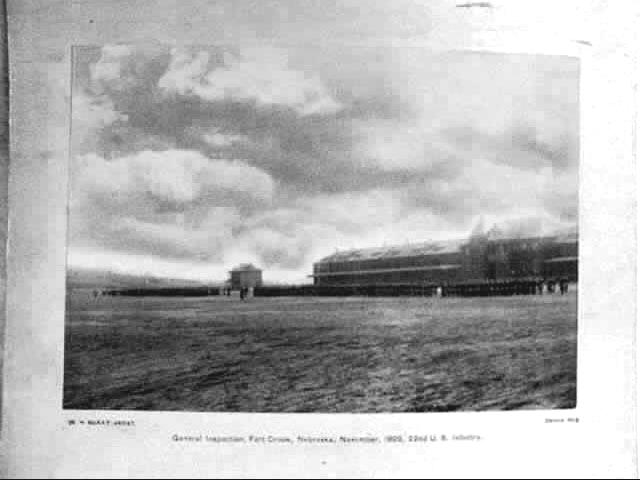
"General
Inspection, Fort Crook, Nebraska, November 1902, 22nd U. S.
Infantry"
Although a poor scan of the original photo, it appears that the
entire Regiment
has gathered at Fort Crook for this inspection.
SERVICE IN THE UNITED STATES 1902-3
The third battalion embarked on
the Rosecrans and sailed January 24, 1902; headquarters, the
first, and the second battalions
sailed on the Hancock February 1. The voyage homeward was very
rough, the Hancock traveling through storm after storm
from Nagasaki to San Francisco. During one of these storms, two
men of the casual detachment were washed overboard.
The Rosecrans entered "Frisco" harbor on the evening of
February 25; a few hours later the Hancock dropped anchor within
hailing distance.
The regiment at once moved into
camp at the Presidio, remaining there until March 4, 5, and 6,
when the various companies moved by rail
to their assigned posts.
Company C took station at Fort
Logan H. Roots, Arkansas, March 9;
companies A and D, at Fort Robinson, Nebraska, March 8;
company B, at Fort Niobrara, Nebraska, March 9;
headquarters, the second, and the third battalions, at Fort
Crook, Nebraska, March 11.
Private Milus L. Mull of Company F died of penumonia on April 22, 1902 at Fort Crook, Nebraska.
May 7-9, companies A and D
changed station to Fort Reno, I. T.; August 18-21, company B
changed station from Fort Niobrara
to Fort Logan H. Roots. No additional changes of stations were
made until the regiment was ordered to its second tour of duty in
the Philippines.
Private William S. Berrill of Company K died of dysentery on July 8, 1902.
Garrison duty, during the
regiment's brief stay in the United States, was almost as
exacting as field service. Drills and parades, target practice,
military athletics, summer exercises, fall maneuvers, schools for
officers and men, and the necessary studies, combined to make
strenuous service.
Each year the companies at Fort Crook, by battalion, marched one
hundred and eighty miles to and from their target range
on the Omaha Indian reservation; in addition, in 1902, these
companies marched four hundred miles to and from Fort Riley,
Kansas.
August 1, the third battalion, Major Crittenden commanding,
attended the reunion of the National society, army of the
Philippines, at Council Bluffs, Iowa.
For the season of 1902, the
regiment won first place in the department rifle competition at
Fort Leavenworth, and second place
in the army competition at Fort Sheridan, Illinois. 1st Sergeant
Archie Deuberry, company B, won both places.
(Ed., Note: the correct spelling of this soldier's name is Deubery. In various accounts his name is spelled as Deuberry or Dewberry.)
"First
Sergeant Archie Deuberry, Company B, 22d Infantry, was the only
man to earn a distinguished marksman shield in 1902.
Previously, he had won only a silver second class prize for a
third-place finish in the 1894 Department of the Platte infantry
match
while he was a private in F Company, 22d Infantry. Deuberry did
poorly in the preliminary 1902 competition conducted during the
last two days
in July, placing fourteenth by scoring 100 points less than the
first-place finisher, the regimental quartermaster sergeant from
his own unit.
Deuberry steeled his nerves and for the first three days of
August shot the best of all entrants, finishing first with a
score of 503 points.
His first 1902 medal was the department gold first prize. Having
started by earning a D-13 prize (ed., 3rd
place silver medal 1894) ,
Deuberry shortly went on to win a coveted second-place gold at
the army level." ²
|
Left: Article from the San Francisco
Call, Volume 87, Below: The gold first prize 1902
Department medal
|
|
Left: Part of the Army
Infantry rifle team In the center is 1st Sergeant
Archie Deubery On his right sleeve Deubery
wears the new model 1902 The Sergeant on his right and
the 1st Sergeant on his left Photo from the Army and Navy Register August 1, 1903 |
The regiment was concentrated at
Fort Riley in September for fall maneuvers. As this was the first
assembly of troops
for experimental field purposes, great interest was taken in the
event. Invitations were extended by the war department to the
states;
many of the states accepted and sent representatives from the
officers of their national guards. The Riley reservation became a
huge camp,
from which, each morning, marched a khaki army to oppose an army
in blue. These forces were employed in action according to
pre-arranged plans;
the results of combat at various points were judged by
disinterested umpires. And in order to obtain all possible
benefits, lyceums were held nightly;
at these, the senior umpire read reports and decisions of the
day's maneuvers. The regimental commander, Colonel James Miller,
commanding a brigade of the 18th and the 22nd infantries, two
batteries, and River's squadron of the 4th cavalry,
won what was judged the only decisive victory of the maneuvers.
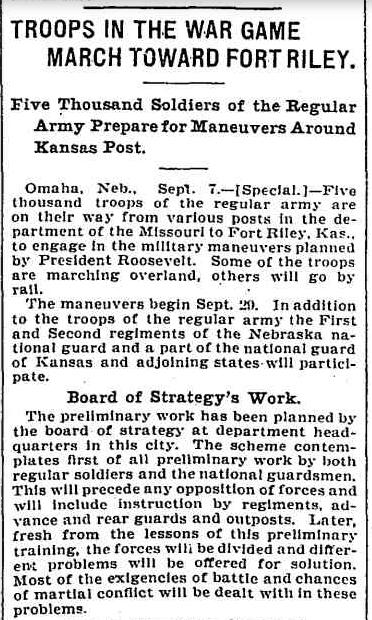
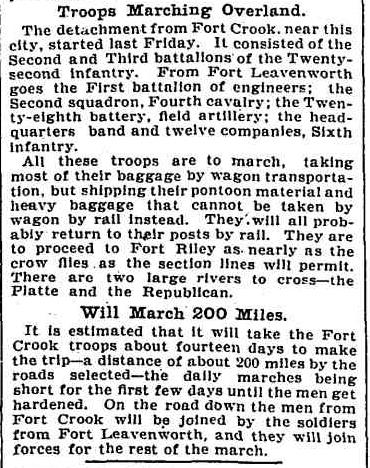
Above: Article
announcing the march of troops to the fall maneuvers at Fort
Riley, Kansas.
The Fort Crook troops mentioned in the article are the Second and
Third Battalions of the
22nd Infantry. Note the article states it will take the 22nd
Infantry troops about fourteen days
to march the 200 miles to Fort Riley from Fort Crook.
From the Chicago Tribune September 8, 1902
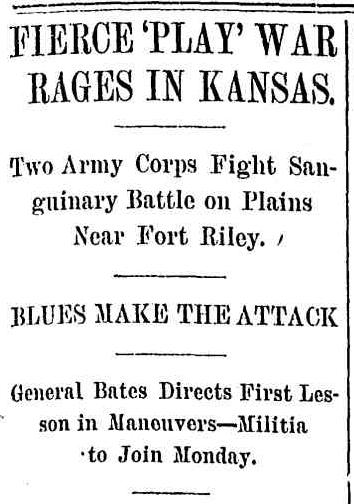
Above: the title of an
article describing the fall maneuvers of 1902
at Fort Riley, Kansas. The text of the article is immediately
below:
FIERCE 'PLAY' WAR RAGES IN
KANSAS.
Two Army Corps Fight San-
guinary Battle on Plains
Near Fort Riley.
BLUES MAKE THE ATTACK
General Bates Directs First Les-
son in Maneuvers---Militia
to Join Monday.
[BY A STAFF CORRESPONDENT]
Fort Riley, Kas., Sept. 27.-[Special.]- Under command of Col.
Kobbe, who only two months ago returned from the swamps of the
Philippines,
the army of the " Blue " at Fort Riley today swept over
the Kansas reservation and fought the army of the " Brown
" under command of Col. C. C. Carr, to a finish.
Technically, two entire army divisions, having a constructive
strength of 24,000 men, were in action. Every problem which would
have confronted two opposing army corps
in the field was met. For five hours the battle raged, the troops
mowing their way through the blue stem grass, which swept the
backs of the horses, under a broiling sun.
In the thick of the fight, moving from hill to hill, as lines
were shifted, rode Maj. Gen. Bates and his staff. Militiamen from
more than a dozen states followed every movement,
studying the methods of Uncle Sam's regulars in action. There
were major generals, brigade generals, and colonels and captains
from Virginia, from New Mexico, from
Texas, and from California.
Battle Lasts Three Hours.
On Monday an army of militiamen, 4,000 strong, will march into
camp, and then more extended maneuvers will begin. Today's
military problem dealt with the handling
of an army's advance guard and the deployment of an entire
division under the enemy's fire.
For three hours the troops scampered about the big 20,000 acre
plot which composes the reservation, then, under the roar of
artillery, the charging of cavalry and the
rattle of infantry fire, the columns, looking like lines of
midgets from the points of vantage afforded by the hills, plowed
their way over the valleys and swales
in the general advance; then, when the opposing forces were 200
yards from each other, divided by a bulky ridge, the umpires sent
the command " cease firing "
around the lines through the wigwaggers with the signal flaus and
the battle was ended.
The marching force, when it swept down by rushes on the enemy and
his roaring artillery, formed a line of blue clad men extending
in a three mile front over the hills
and ravines. On a plateau to the east the handful of cavalrymen
and sweating artillerymen who wore the brown used every maneuver
to check the advance of the "Blue".
Discuss Blunders of Day.
Tonight in the big mess tent commanding officers and umpires are
discussing the work of the day. Those guilty of false steps are
having their faults pointed out.
Those who handled their men so that every natural advantage
offered by the country was utilized are being commended, for this
is a big school of military instruction,
and the problems of war are being discussed and taught just as a
college student faces his Greek or his mathematics in the
classroom. With all the flighting there is
never a formal decision as to which army has won, though the
criticisms show the commanders that they may draw their own
deduction.
Blues Move to Attack.
It was only a few minutes after 8 O'clock when the columns moved
out from the big main camp. At the head of the line moved a
battalion of engineers, fully equipped
for field service. A squadron of the Fourth cavalry followed
them. Then came the six guns of the Seventh battery, the entire
Eighteenth regiment of Infantry, and,
eight companies of the Twenty-second, the
"doughboys" trekking over the dirt road on the double
quick. A bunch of men from the signal corps came next,
followed by a string of wagons bearing ammunition and the picks
and shovels needed for entrenchment work.
Six ambulances closed the column, telling the story of what marks
the close of a real battle.
A quarter of an hour later, and 3,100 men of all branches of the
service filed down the road, swinging along after the manner of
an army on a long march. Sandwiched among the batteries moved the
little line of mules that compose the mountain artillery.
Down the winding road, edged by its heavy growth of trees, the
column made its way. It passed out on the bank of the Republican
river; the men, when seen
from the heights above, looked like giant centipedes.
" Brown " Army on Hills.
Four miles away to the east on the edge of a plateau veiled by
rolling hills the army of the " Brown " had taken up
its position. Here Col. Carr had two squadrons of cavalry
and the Sixth battery with its six field guns. Behind was an
imaginary army division of 10,000 men.
Prom the heights above the river Gen. Bates watched his men. The
army of the " Blue " looked to be crawling along like a
huge dragon. Then the bugles took up their music
and turning abruptly to the east, the army made its way through
the deep ravines.
It was over just such ground as the men of the civil war tought
the battles of Chickamauga and of Shiloh.
Cavalry Opens the Attack.
At a call from the bugles two troops of cavalry scampered away up
the deep gullies. Behind them, as a reserve, a battalion of the Twenty-second
Infantry hoofed ahead
on the double quick. Two guns of the artillery plowed their way
to thr front at a gallop, the men swaying on the carriages as
they were swept up and down the hills and
through the ravines. Ammunition wagons and the wagons and the
wagons bearing the intrenchment tools bumped along in the rear,
followed by two guns of the
mountain battery, the cannoneers tramping alongside the mules
that carried the folded carriages and the light guns. The
remainder of the advancing army formed the reserve.
Defenders Open Fire.,
Suddenly ahead the spitting of carbines told that the advance
guard had struck the cavalry of the " Browns." A
scouting force had been out watching for the coming
of the enemy. This scouting force, too, had to find out for
itself just where the enemy was advancing, as no previous
instructions are given which would make the
maneuvers merely a prearranged series of sham battles.
It is real war from start to finish so far as the problems
presented are concerned.
From the plateau two miles to the east there came a puff of smoke
and " Carr's battery " was in action, meeting the
enemy's advance. In the meantime, to the roll of
the artillery, the opposing cavalry were maneuvering to exactly
locate the conditions marking the disposition of the opposing
forces.
Then the deployment of the advancing force began. A battalion of
the Twenty-second Infantry advanced in extended
order, the men scattered in long lines and making
their gains by rushes, and then dropping to the ground. Only the
enemy's artillery, trumping away to the east, told where the
" Brown " force was intrenched.
The lines of the Twenty-second were sent to the
heights as flankers for the advancing columns, the men closing
almost three miles over the hills to reach this position
on the right of the main force. A battalion of the Eighteenth
infantry effected the same maneuver to the left.
The advancing army crept on, the men in loose order, leaving it
to the advance guard to pave the way and do the fighting. Then,
the " Brown " battery constructively
having been effective at 3,500 yards, the commanders began to
take advantage of every natural protection afforded by the ridges
and the ravines.
The men were cautioned, lest the umpires should find them
exposed, and rule them out , as " constructively " dead
soldiers.
As the advance lines swept up over a ridge the first capture of
the fight took place. They plumped into a little bunch of
"Brown" cavalry and the khaki clad riders
were taken into camp in a hurry on the signal of an umpire.
" Constructively " they were prisoners of war, and on
the " Blue " lines went crawling along now and
dodging along in the heavy grass, whose roots formed traps for
the feet of the unwary infantrymen.
From the hills to the north there came an answering roar to the
thudding guns of the "Browns," the artillery of the
advancing force had wheeled its guns on this point
of vantage and the sweating cannoneers added their protection to
the advancing troops.
Swing Into Line of Battle.
In the meantime bugles were calling along the blue clad line.
Like a great fan this line of blue opened. Battalions of men were
wheeled to either side, scattering,
and always advancing. From the hills they looked like so many
giant ants, whose workday grind had been disturbed by some chance
pedestrian. With machinelike
precision this breakup continued until a line of creeping blue
men, extended its length north and south for three miles,
sweeping on toward the plateau to the east,
where the guns of the battery were roaring their defiance. The
entire Seventh battery of the marching forces has taken up its
position on the right. In line with their guns
the two remaining battalions of the Twenty-second
Infantry had debauched their men in long broken lines.
Then the Eighteerith infantry and the remaining artillery
was in the same position with the other end.
From far off to the left the rattle of rifles, spanking the air
with quick, sharp reports, told where the advancing flankers had
met a detachment of the enemy's cavalry.
Over there the Sixth Infantry was quickly deployed. While the
rattle of the rifles and artillery was being waged there, the
lines on the right settled down, awaiting the
advance of the battery of the " Blues," which had first
unlimbered.
Eat Under Heavy Fire.
Lying down in the deep grass, which afforded relief from the
midday sun, the men dug in their haversacks and made a hurried
lunch. When the advancing force finally
had swung into one great line, extending almost four miles over
the roving hills and the precipitous ravines, the battle had
ended. Gen. Kobbe had pushed his advance
forward while the main body of his army was completing its
deployment, and Col. Carr had disposed his small force so as to
outline the position of an entire army division.
That is all there was to the day's problem. It had given just as
much experience as if 12,000 men instead of 5,000 had made the
advance and had been confronted by
an opposing force of the same number instead of the handful which
formed Col. Carr's real command.
Signal Men Work Hard.
On the hills, which lend to the country an air of the kopjes of
the south African veldt, signal men had been hard at work.
Wigwaggers were sending information
from one end of the line to the other with their waving flags.
Another squad was flashing its heliographs as if a real campaign
was being waged.
The medical corps had set up their dressing stations where
wounded men are given their first examination before being sent
to the hospitals. Men with stretchers
had crept through the grass and over the ledges for sandstone
formations, picking up men who had been ruled to be "
constructively " dead by the umpires.
The army was formed in column again. with its wagon trains and
their convoys, and the long march of five miles back to camp was
begun. Over on the slope of a
sweeping hill two full batteries of artillery formed in battery
front, wheeling off in a solid mass of black guns and blue
uniforms until the carriages swept out singly
on the dirt road which skirts the river.
During the battle the umpires moved over the fields with the
various battalions in action. They were In command of Col. Wagner
as chief umpire with the " blues ".
Major Knight of the engineers served as senior umpire with the
" browns," Col. Augur of the Tenth cavalry and their
eleven assistants were drawn from all branches
of the service---infantry, cavalry, ordnance department, and
engineers.
Militia in Monday's Action.
With dawn of Monday the national guardsmen will begin to arrive,
and then, the big school, for that is what Gen. Bates calls it,
will be full. Problems of every kind
will be presented the militiamen to solve. There will be lectures
to militia quartermasters by Capt. Baker, chief quartermaster.
There will be lectures to commissary officers
by the head of this department of the regular army, and then, in
actual field practice, both regulars and militiamen will be
taught the profession of arms under modern conditions.
Tomorrow the big camp will rest, except that the " rooters
" will remain out to howl for the opposing sides in a
baseball battle, in which cavalry and infantry
will try conclusions in the national game.
From the Chicago Tribune
September 28, 1902
From the Chicago Tribune website
Companies A and D returned to
Fort Reno, October 8; companies B and C, to Fort Logan H. Roots,
October 10;
the second and the third battalions, to Fort Crook, October 22.
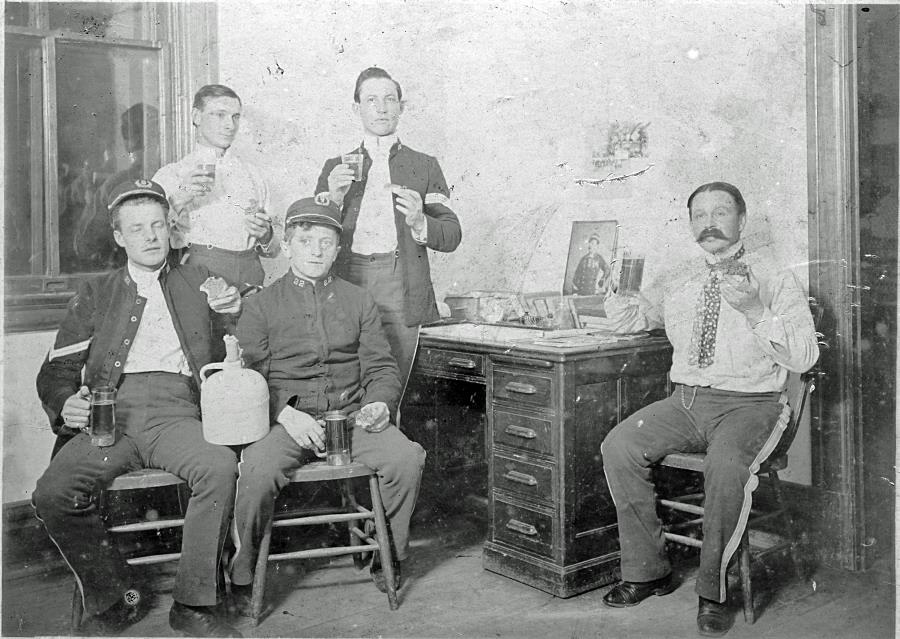
Musicians of the 22nd
Infantry Regimental Band at Fort Crook 1902
They are still wearing the model 1895 forage cap, with musician
insignia and a gold cap band, the model 1902 cap
most likely not making its way into the band's inventory yet.
Instead of wearing a "22" in their cap insignia,
they have added the number "22" to their collars. These
collar numbers would have been the individual number
"2"
applied twice to form the number "22".
Photo from the webmaster's collection
|
Article from the New York
Times Note that First Lieutenant
David L. Stone |
Private Eugene F. P. Brewster of Company C died from paralysis on February 9, 1903.
April 28, 1903, the second and
the third battalions were sent to St. Louis, Missouri, to take
part in the parade incidental
to the dedication of the Louisiana Purchase exposition; the
battalions returned to Fort Crook, May 4, 1903.
Musician William Leary Jr. of Company G was
killed by a freight train on March 10, 1903.
Private Louis H. Vanatta of Company D died of penumonia on July
3, 1903.
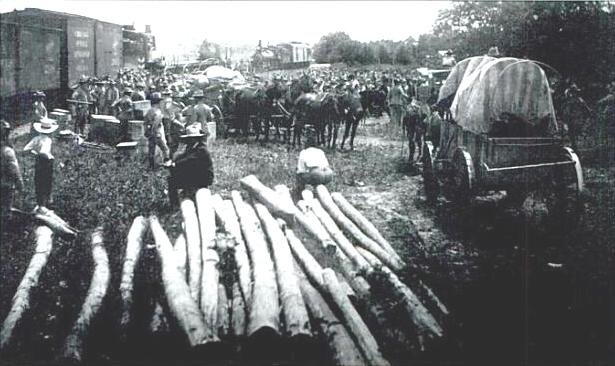

Ed., Bancroft, Nebraska was
approximately sixty miles from Fort Crook.
The above photo appears to show the Soldiers of the 22nd Infantry
in the process of
unloading their supplies from the train and transferring them
into wagons.
Photo from:
Historic Railroads of Nebraska
By Michael M. Bartels, James J. Reisdorff
Published by Arcadia Publishing, 2002
Ed., On the 11th of August, 1903, Colonel Henry Wygant became Commander of the 22nd Infantry Regiment.
The regiment again won first
place in the annual department rifle competition at Fort
Leavenworth, Kansas, (Corporal William A. Vickery, company C)
and eighth place in the army competition at Fort Sheridan,
Illinois. (1st Sergeant Archie Deuberry, company B).
|
Left: Corporal William A. Vickery of
Company C 22nd Infantry. In the summer of 1903 Vickery
won First Place in the rifle Vickery enlisted in Company C
of the 22nd Infantry on January 6, 1902 at He further served two
enlistments in the Coastal Artillery until discharged Photo from the Army and Navy Register August 1, 1903 |
October 20 and 21, 1903, the
regiment left its peaceful stations for San Francisco, en route
to the Philippines.
October 31, it embarked and sailed on the U. S. A. T. Sheridan.
Ed., The Regiment sailed to the Philippines on October 31 with 48 Officers and 733 enlisted men. ¹
After stopping at Honolulu,
November 8-10, and at Guam, November 22-23,
the Sheridan arrived at Manila November 28. Here, definite orders
were received, assigning the regiment to service in Mindanao;
the Sheridan sailed from Manila bay December 1, and arrived at
Camp Overton December 3. The regiment disembarked the following
day.
December 6, the second battalion took station at Pantar;
headquarters, the first and the third battalions, at Camp
Marahui.
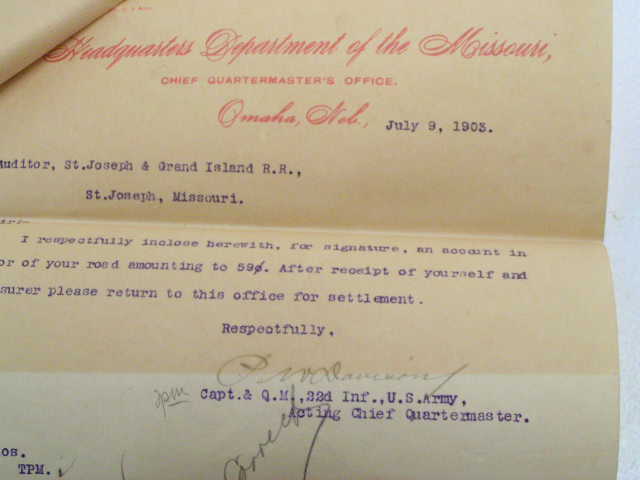
A bill sent to the St. Joseph &
Grand Island Railroad, for the amount of fifty-nine cents,
and dated July 9, 1903 at Fort Crook, Nebraska.
Signed by Captain Peter W. Davidson, who, in his position as
Quartermaster of the 22nd Infantry,
was, at the time, also acting Chief Quartermaster for the US
Army's Department of the Missouri.
Below are photos of a model 1898 Krag
rifle, issued in 1903
and bearing markings for H Company of the 22nd Infantry:

The rifle, showing the 22nd Infantry marking on the buttstock.
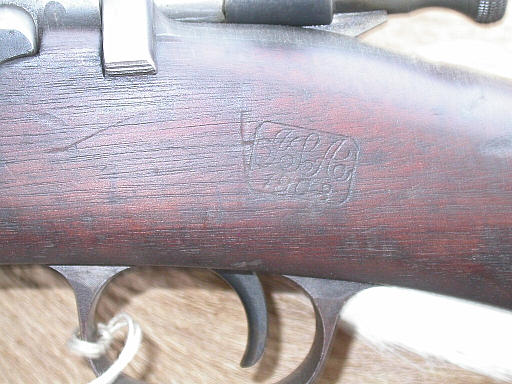
The issue cartouche on the rifle,
bearing the initials "JSA", for J. Sumner Adams,
who was the chief inspector of rifles, and the issue date of
1903.
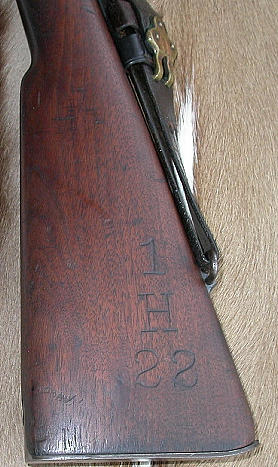
Closeup of the stock, clearly showing the markings for H Company 22nd Infantry.
Photos of the 1898 Krag rifle courtesy of Vic Samuel LTC USA (Retired)
See Vic's website by clicking on the following link:
Narrative from the 1904 Regimental History
¹ Annual Reports to the Secretary of War 1904
² Marksmanship in the U.S. Army: A History
of Medals, Shooting Programs, and Training
by William K. Emerson University of Oklahoma Press, 2004
Additional material added by the website editor
Additional information taken from:
Returns from Regular Army Infantry
Regiments, June 1821–December 1916. NARA
microfilm publication M665
National Archives and Records Administration, Washington, D.C.
Home | Photos | Battles & History | Current |
Rosters & Reports | Medal of Honor | Killed
in Action |
Personnel Locator | Commanders | Station
List | Campaigns |
Honors | Insignia & Memorabilia | 4-42
Artillery | Taps |
What's New | Editorial | Links |